Preserving Sculptural Heritage in the Era of Digital Transformation: Methods and Challenges of 3D Art Assessment
Abstract
1. Introduction
- How does one evaluate a work of digital art, mainly 3D sculpture, from a sustainable perspective?
- What distinguishing characteristics do digital artworks (digital sculptures) have compared to traditional artworks (such as traditional sculptures)?
- Which artistic qualities are subjectively perceived to contribute to the digital transformation of cultural heritage?
2. Literature Review
2.1. Digital Transformation as a Method to Promote Sustainability
2.2. Challenges of Preserving Artwork through Digitisation
2.3. Evaluation Method for 3D Artwork
3. Materials and Methods
3.1. Participants and Screening Questionnaire
3.2. Procedure
3.3. Assessment of Art Attributes
3.4. System Design of the Stimuli
3.5. Data Analysis Method
4. Results
4.1. Descriptive Statistics
4.2. Validity Analysis
4.3. Correlation Analysis
4.4. Variable Importance Analysis
4.5. Regression Model Comparison
5. Discussion
- Visual harmony: The senior group rated physical sculptures’ visual harmony slightly higher than the youth group, indicating a preference for the visual performance of traditional sculptures.
- Colour saturation and variety: The scores of the two groups are similar, and there is a general belief that digital sculpture performs better in these areas. These visual-related dimensions received high ratings, reflecting participants’ overall positive assessment of the colour performance of digital sculptures, emphasising the role of advanced digital technology in enhancing the expressive power of artistic works.
6. Conclusions
- This study shows that our improved semantic differential scale based on 15 artistic attributes can effectively evaluate digital artworks. This approach opens up new research avenues for assessing the digital transformation of three-dimensional artworks, especially digital sculptures. Some new dimensions are provided for the digital sustainable restoration of sculptures;
- Compared with traditional art forms, digital artworks are more popular among young people. Digital artwork is rated higher on attributes such as colour variation (e), colour saturation (d), and texture (h), indicating that it is more expressive. In terms of the sustainable dissemination of cultural heritage, the digital art form has a strong appeal to young people, which is related to its ability to promote the intergenerational inheritance of sculpture art. In addition, digital works reflect stronger social attributes and are more in line with contemporary trends;
- The research results show that the virtual sculpture successfully demonstrated its artistic value, which demonstrates the potential of digital transformation in cultural heritage preservation. In the transformation, complexity, social, texture, depth, and imaginativeness attributes are significantly related to the value of digital artworks. The assessment of virtual sculpture could focus on those attributes to simplify the assessment process without loss of evaluation performance.
Author Contributions
Funding
Institutional Review Board Statement
Informed Consent Statement
Data Availability Statement
Acknowledgments
Conflicts of Interest
Appendix A. Questionnaire
| ||||
| 1. Never | 2. Occasionally | 3. Monthly | 4. Weekly | 5. Daily |
| ||||
| 1. Shape | 2. Value | 3. Culture | 4. Artist | 5. Material |
| ||||
| 1 | 2 | 3 | 4 | 5 |
| ||||
| 1 | 2 | 3 | 4 | 5 |
| ||||
| 1. Never | 2. Occasionally | 3. Monthly | 4. Weekly | 5. Daily |
| ||||
| 1. Technology | 2. Creativity | 3. Interactivity | 4. Visual Effects | 5. Artist |
| ||||
| 1 | 2 | 3 | 4 | 5 |
| ||||
| 1 | 2 | 3 | 4 | 5 |
| ||||
| 1. Physical | 2. Digital | 3. Both | ||
| ||||
| 1. Physical | 2. Digital | 3. Same | ||
| ||||
| 1. Physical | 2. Digital | 3. Same | ||
| ||||
| 1. Physical | 2. Digital | 3. Same | ||
| ||||
| 1 | 2 | 3 | 4 | 5 |
| N | Minimum | Maximum | Mean | Std. Deviation | Skewness | Kurtosis | |||
|---|---|---|---|---|---|---|---|---|---|
| Statistic | Statistic | Statistic | Statistic | Statistic | Statistic | Std. Error | Statistic | Std. Error | |
| Age | 60 | 18 | 45 | 27.95 | 8.765 | 0.638 | 0.309 | −1.047 | 0.608 |
| a. Visual harmony | 60 | 1 | 5 | 3.18 | 0.770 | −0.331 | 0.309 | 1.335 | 0.608 |
| b. Depth | 60 | 1 | 5 | 3.57 | 1.280 | −0.429 | 0.309 | −0.954 | 0.608 |
| c. Complexity | 60 | 1 | 5 | 3.97 | 1.149 | −0.903 | 0.309 | −0.115 | 0.608 |
| d. Colour saturation | 60 | 2 | 5 | 4.23 | 0.767 | −0.663 | 0.309 | −0.213 | 0.608 |
| e. Colour variety | 60 | 3 | 5 | 4.40 | 0.694 | −0.731 | 0.309 | −0.610 | 0.608 |
| f. Colour temperature | 60 | 1 | 5 | 2.97 | 0.736 | −0.212 | 0.309 | 1.142 | 0.608 |
| g. Reflective colour | 60 | 1 | 5 | 2.20 | 1.205 | 0.744 | 0.309 | −0.413 | 0.608 |
| h. Texture | 60 | 1 | 5 | 4.00 | 1.193 | −1.239 | 0.309 | 0.729 | 0.608 |
| i. Touch | 60 | 1 | 5 | 1.40 | 0.718 | 2.640 | 0.309 | 9.859 | 0.608 |
| j. Abstraction | 60 | 1 | 5 | 3.18 | 1.334 | −0.171 | 0.309 | −0.986 | 0.608 |
| k. Imaginativeness | 60 | 1 | 5 | 3.97 | 1.562 | −1.268 | 0.309 | −0.100 | 0.608 |
| l. Symbolism | 60 | 1 | 5 | 2.92 | 0.671 | −0.598 | 0.309 | 3.353 | 0.608 |
| m. Emotion | 60 | 1 | 5 | 3.30 | 1.510 | −0.411 | 0.309 | −1.271 | 0.608 |
| n. Social | 60 | 1 | 5 | 4.02 | 1.372 | −1.213 | 0.309 | 0.101 | 0.608 |
| o. Value | 60 | 1 | 5 | 3.37 | 1.507 | −0.535 | 0.309 | −1.171 | 0.608 |
| id | 60 | 1 | 60 | 30.50 | 17.464 | 0.000 | 0.309 | −1.200 | 0.608 |
| Formal–perceptual attributes | 60 | 2.11 | 4.11 | 3.3241 | 0.38884 | −0.672 | 0.309 | 0.755 | 0.608 |
| Content–representational attributes | 60 | 2.00 | 4.50 | 3.3417 | 0.56742 | −0.176 | 0.309 | −0.403 | 0.608 |
| Value attributes | 60 | 1.00 | 5.00 | 3.6917 | 1.32477 | −0.906 | 0.309 | −0.539 | 0.608 |
| Valid N (listwise) | 60 | ||||||||
| Test Value = 3 | ||||||
|---|---|---|---|---|---|---|
| t | df | Sig. (2-Tailed) | Mean Difference | 95% Confidence Interval of the Difference | ||
| Lower | Upper | |||||
| a. Visual harmony | 1.844 | 59 | 0.070 | 0.183 | −0.02 | 0.38 |
| b. Depth | 3.428 | 59 | 0.001 | 0.567 | 0.24 | 0.90 |
| c. Complexity | 6.515 | 59 | 0.000 | 0.967 | 0.67 | 1.26 |
| d. Colour saturation | 12.451 | 59 | 0.000 | 1.233 | 1.04 | 1.43 |
| e. Colour variety | 15.630 | 59 | 0.000 | 1.400 | 1.22 | 1.58 |
| f. Colour temperature | −0.351 | 59 | 0.727 | −0.033 | −0.22 | 0.16 |
| g. Reflective colour | −5.145 | 59 | 0.000 | −0.800 | −1.11 | −0.49 |
| h. Texture | 6.492 | 59 | 0.000 | 1.000 | 0.69 | 1.31 |
| i. Touch | −17.266 | 59 | 0.000 | −1.600 | −1.79 | −1.41 |
| j. Abstraction | 1.065 | 59 | 0.291 | 0.183 | −0.16 | 0.53 |
| k. Imaginativeness | 4.794 | 59 | 0.000 | 0.967 | 0.56 | 1.37 |
| l. Symbolism | −0.962 | 59 | 0.340 | −0.083 | −0.26 | 0.09 |
| m. Emotion | 1.539 | 59 | 0.129 | 0.300 | −0.09 | 0.69 |
| n. Social | 5.742 | 59 | 0.000 | 1.017 | 0.66 | 1.37 |
| o. Value | 1.885 | 59 | 0.064 | 0.367 | −0.02 | 0.76 |
| Formal–perceptual attributes | 6.456 | 59 | 0.000 | 0.324 | 0.22 | 0.42 |
| Content–representational attributes | 4.664 | 59 | 0.000 | 0.342 | 0.20 | 0.49 |
| Value attributes | 4.044 | 59 | 0.000 | 0.692 | 0.35 | 1.03 |
References
- Sargentis, G.-F.; Frangedaki, E.; Chiotinis, M.; Koutsoyiannis, D.; Camarinopoulos, S.; Camarinopoulos, A.; Lagaros, N.D. 3D scanning/printing: A technological stride in sculpture. Technologies 2022, 10, 9. [Google Scholar] [CrossRef]
- Sargentis, G.-F.; Dimitriadis, P.; Iliopoulou, T.; Koutsoyiannis, D. A Stochastic View of Varying Styles in Art Paintings. Heritage 2021, 4, 333–348. [Google Scholar] [CrossRef]
- Kantaros, A.; Soulis, E.; Alysandratou, E. Digitization of ancient artefacts and fabrication of sustainable 3D-printed replicas for intended use by visitors with disabilities: The case of Piraeus archaeological museum. Sustainability 2023, 15, 12689. [Google Scholar] [CrossRef]
- Short, D.B. Use of 3D printing by museums: Educational exhibits, artifact education, and artifact restoration. 3D Print. Addit. Manuf. 2015, 2, 209–215. [Google Scholar] [CrossRef]
- Neumüller, M.; Reichinger, A.; Rist, F.; Kern, C. 3D printing for cultural heritage: Preservation, accessibility, research and education. In 3D Research Challenges in Cultural Heritage: A Roadmap in Digital Heritage Preservation; Springer: Berlin/Heidelberg, Germany, 2014; pp. 119–134. [Google Scholar]
- Malik, U.; Tissen, L.N.; Vermeeren, A.P. 3D reproductions of cultural heritage artifacts: Evaluation of significance and experience. Stud. Digit. Herit. 2021, 5, 1–29. [Google Scholar] [CrossRef]
- Khan, N.A.; Shafi, S.; Ahangar, H. Digitization of cultural heritage: Global initiatives, opportunities and challenges. J. Cases Inf. Technol. (JCIT) 2018, 20, 1–16. [Google Scholar] [CrossRef]
- Bachi, V.; Fresa, A.; Pierotti, C.; Prandoni, C. The digitization age: Mass culture is quality culture. Challenges for cultural heritage and society. In Digital Heritage. Progress in Cultural Heritage: Documentation, Preservation, and Protection, Proceedings of the 5th International Conference, EuroMed 2014, Limassol, Cyprus, 3–8 November 2014; Proceedings 5; Springer: Cham, Switzerland, 2014; pp. 786–801. [Google Scholar]
- Savov, S.A.; Antonova, R.; Spassov, K.; Muschalik, T. Multimedia applications in digital transformation art. In Sustainable Development and Social Responsibility—Volume 1, Proceedings of the 2nd American University in the Emirates International Research Conference, AUEIRC’1—Dubai, United Arab Emirates, 13–15 November 2018; Springer: Cham, Switzerland, 2020; pp. 121–124. [Google Scholar]
- Belhi, A.; Foufou, S.; Bouras, A.; Sadka, A.H. Digitization and preservation of cultural heritage products. In Product Lifecycle Management and the Industry of the Future, Proceedings of the 14th IFIP WG 5.1 International Conference, PLM 2017, Seville, Spain, 10–12 July 2017; Revised Selected Papers 14; Springer: Cham, Switzerland, 2017; pp. 241–253. [Google Scholar]
- Jo, Y.H.; Hong, S.; Jo, S.Y.; Kwon, Y.M. Noncontact restoration of missing parts of stone Buddha statue based on three-dimensional virtual modeling and assembly simulation. Herit. Sci. 2020, 8, 103. [Google Scholar] [CrossRef]
- Plucker, J.A.; Beghetto, R.A.; Dow, G.T. Why isn’t creativity more important to educational psychologists? Potentials, pitfalls, and future directions in creativity research. Educ. Psychol. 2004, 39, 83–96. [Google Scholar] [CrossRef]
- Li, C.; Chen, T. Aesthetic visual quality assessment of paintings. IEEE J. Sel. Top. Signal Process. 2009, 3, 236–252. [Google Scholar] [CrossRef]
- Iigaya, K.; Fonseca, M.S.; Murakami, M.; Mainen, Z.F.; Dayan, P. An effect of serotonergic stimulation on learning rates for rewards apparent after long intertrial intervals. Nat. Commun. 2018, 9, 2477. [Google Scholar] [CrossRef] [PubMed]
- Iigaya, K.; Yi, S.; Wahle, I.A.; Tanwisuth, K.; O’Doherty, J.P. Aesthetic preference for art emerges from a weighted integration over hierarchically structured visual features in the brain. bioRxiv 2020. [Google Scholar] [CrossRef]
- Spee, B.T.; Mikuni, J.; Leder, H.; Scharnowski, F.; Pelowski, M.; Steyrl, D. Machine learning revealed symbolism, emotionality, and imaginativeness as primary predictors of creativity evaluations of western art paintings. Sci. Rep. 2023, 13, 12966. [Google Scholar] [CrossRef] [PubMed]
- Kozbelt, A.; Seeley, W.P. Integrating art historical, psychological, and neuroscientific explanations of artists’ advantages in drawing and perception. Psychol. Aesthet. Creat. Arts 2007, 1, 80. [Google Scholar] [CrossRef]
- Pelowski, M.; Markey, P.S.; Goller, J.; Förster, E.L.; Leder, H. But, how can we make “art?” Artistic production versus realistic copying and perceptual advantages of artists. Psychol. Aesthet. Creat. Arts 2019, 13, 462. [Google Scholar] [CrossRef]
- Berlyne, D.E. Dimensions of perception of exotic and pre-Renaissance paintings. Can. J. Psychol./Rev. Can. Psychol. 1975, 29, 151. [Google Scholar] [CrossRef]
- Cupchik, G.C.; Berlyne, D.E. The perception of collative properties in visual stimuli. Scand. J. Psychol. 1979, 20, 93–104. [Google Scholar] [CrossRef]
- Wang, T.; Cant, J.S.; Cupchik, G. The impact of depth of aesthetic processing and visual-feature transformations on recognition memory for artworks and constructed design patterns. Empir. Stud. Arts 2016, 34, 193–220. [Google Scholar] [CrossRef]
- Fekete, A.; Pelowski, M.; Specker, E.; Brieber, D.; Rosenberg, R.; Leder, H. The Vienna Art Picture System (VAPS): A data set of 999 paintings and subjective ratings for art and aesthetics research. Psychol. Aesthet. Creat. Arts 2022, 17, 660–671. [Google Scholar] [CrossRef]
- Pelowski, M.; Gerger, G.; Chetouani, Y.; Markey, P.S.; Leder, H. But is it really art? The classification of images as “Art”/“Not Art” and correlation with appraisal and viewer interpersonal differences. Front. Psychol. 2017, 8, 271275. [Google Scholar] [CrossRef]
- Leder, H.; Gerger, G.; Brieber, D.; Schwarz, N. What makes an art expert? Emotion and evaluation in art appreciation. Cogn. Emot. 2014, 28, 1137–1147. [Google Scholar] [CrossRef]
- Leder, H.; Gerger, G.; Dressler, S.G.; Schabmann, A. How art is appreciated. Psychol. Aesthet. Creat. Arts 2012, 6, 2. [Google Scholar] [CrossRef]
- Van Paasschen, J.; Bacci, F.; Melcher, D.P. The influence of art expertise and training on emotion and preference ratings for representational and abstract artworks. PLoS ONE 2015, 10, e0134241. [Google Scholar] [CrossRef] [PubMed]
- Fingerhut, J. Enacting media. An embodied account of enculturation between neuromediality and new cognitive media theory. Front. Psychol. 2021, 12, 635993. [Google Scholar] [CrossRef] [PubMed]
- Jakesch, M.; Leder, H. The qualitative side of complexity: Testing effects of ambiguity on complexity judgments. Psychol. Aesthet. Creat. Arts 2015, 9, 200. [Google Scholar] [CrossRef]
- Van Geert, E.; Wagemans, J. Order, complexity, and aesthetic appreciation. Psychol. Aesthet. Creat. Arts 2020, 14, 135. [Google Scholar] [CrossRef]
- Breiman, L. Statistical modeling: The two cultures (with comments and a rejoinder by the author). Stat. Sci. 2001, 16, 199–231. [Google Scholar] [CrossRef]
- Marin, M.M.; Lampatz, A.; Wandl, M.; Leder, H. Berlyne revisited: Evidence for the multifaceted nature of hedonic tone in the appreciation of paintings and music. Front. Hum. Neurosci. 2016, 10, 536. [Google Scholar] [CrossRef] [PubMed]
- Inanloo Dailoo, S.; Farrokhi, A.; Lu, C. Heritage Documentation and Digital Preservation: The Use of Cloud-Based Services for Heritage Conservation (the Case of ST. Albert River Lots). Int. Arch. Photogramm. Remote Sens. Spat. Inf. Sci. 2023, 48, 729–734. [Google Scholar] [CrossRef]
- Kamal, H.M. Planning for Artefact Installation and the Challenges of Implementation: Behind the Scenes in the King Tutankhamun Gallery at the Grand Egyptian Museum. Stud. Conserv. 2022, 67, 122–129. [Google Scholar] [CrossRef]
- Afsharpour, M.; Hadadi, M. Titanium dioxide thin film: Environmental control for preservation of paper-art-works. J. Cult. Herit. 2014, 15, 569–574. [Google Scholar] [CrossRef]
- Ahmed, H.T.; Aly, A.M. Recycled Waste Materials in Landscape Design for Sustainable Development (Al-Ahsa as a Model). Sustainability 2023, 15, 11705. [Google Scholar] [CrossRef]
- Hernandez-Chavarria, F.; Murillo, A. Five years of total abstinence of any acid: University of Costa Rica’s School of Fine Arts Non-Toxic printmaking experience. Arte Individuo Soc. 2012, 24, 167–177. [Google Scholar]
- García, J.A.M.; Yahaghi, E.; Mirzapour, M.; Movafeghi, A. Improved revealing of hidden structures and defects for historic art sculptures using poisson image editing. J. Cult. Herit. 2022, 55, 381–390. [Google Scholar] [CrossRef]
- Niquet, N.-D.; Sánchez-López, M.; Mas-Barberà, X. Development of reversible intelligent prosthesis for the conservation of sculptures. A case study. J. Cult. Herit. 2020, 43, 227–234. [Google Scholar] [CrossRef]
- Koehl, M.; Fuchs, M. 3D modelling of architectural blocks and antique sculptures for the conservation and the promotion of archaeological heritage–experiments in Alsace. Int. Arch. Photogramm. Remote Sens. Spat. Inf. Sci. 2019, 42, 625–632. [Google Scholar] [CrossRef]
- Sansoni, G.; Trebeschi, M.; Docchio, F. State-of-the-art and applications of 3D imaging sensors in industry, cultural heritage, medicine, and criminal investigation. Sensors 2009, 9, 568–601. [Google Scholar] [CrossRef] [PubMed]
- Bruno, F.; Bruno, S.; De Sensi, G.; Luchi, M.-L.; Mancuso, S.; Muzzupappa, M. From 3D reconstruction to virtual reality: A complete methodology for digital archaeological exhibition. J. Cult. Herit. 2010, 11, 42–49. [Google Scholar] [CrossRef]
- Acke, L.; De Vis, K.; Verwulgen, S.; Verlinden, J. Survey and literature study to provide insights on the application of 3D technologies in objects conservation and restoration. J. Cult. Herit. 2021, 49, 272–288. [Google Scholar] [CrossRef]
- Soler, F.; Melero, F.J.; Luzón, M.V. A complete 3D information system for cultural heritage documentation. J. Cult. Herit. 2017, 23, 49–57. [Google Scholar] [CrossRef]
- Marra, A.; Gerbino, S.; Greco, A.; Fabbrocino, G. Combining Integrated Informative System and Historical Digital Twin for Maintenance and Preservation of Artistic Assets. Sensors 2021, 21, 5956. [Google Scholar] [CrossRef] [PubMed]
- Trunfio, M.; Della Lucia, M.; Campana, S.; Magnelli, A. Innovating the cultural heritage museum service model through virtual reality and augmented reality: The effects on the overall visitor experience and satisfaction. J. Herit. Tour. 2022, 17, 1–19. [Google Scholar] [CrossRef]
- Nguyen, S.V.; Le, S.T.; Tran, M.K.; Tran, H. Reconstruction of 3D digital heritage objects for VR and AR applications. J. Inform. Telecommun. 2022, 6, 254–269. [Google Scholar] [CrossRef]
- Ch’ng, E.; Li, Y.; Cai, S.D.; Leow, F.T. The Effects of VR Environments on the Acceptance, Experience, and Expectations of Cultural Heritage Learning. ACM J. Comput. Cult. Herit. 2020, 13, 21. [Google Scholar] [CrossRef]
- Profico, A.; Bellucci, L.; Buzi, C.; Di Vincenzo, F.; Micarelli, I.; Strani, F.; Tafuri, M.A.; Manzi, G. Virtual Anthropology and its Application in Cultural Heritage Studies. Stud. Conserv. 2019, 64, 323–336. [Google Scholar] [CrossRef]
- Achille, C.; Tommasi, C.; Rechichi, F.; Fassi, F.; De Filippis, E. Towards an advanced conservation strategy: A structured database for sharing 3D documentation between expert users. Int. Arch. Photogramm. Remote Sens. Spat. Inf. Sci. 2019, 42, 9–16. [Google Scholar] [CrossRef]
- Hammer, E.; Seifried, R.; Franklin, K.; Lauricella, A. Remote assessments of the archaeological heritage situation in Afghanistan. J. Cult. Herit. 2018, 33, 125–144. [Google Scholar] [CrossRef]
- McCandlish, A.; McPherson, G. Promoting tangible and intangible hidden cultural heritage: Local communities influencing civic decision-making and international cultural policy. Int. J. Cult. Policy 2021, 27, 683–698. [Google Scholar] [CrossRef]
- Pal, K.; Avery, N.; Boston, P.; Campagnolo, A.; De Stefani, C.; Matheson-Pollock, H.; Panozzo, D.; Payne, M.; Schüller, C.; Sanderson, C. Digitally reconstructing the Great Parchment Book: 3D recovery of fire-damaged historical documents. Digit. Scholarsh. Humanit. 2017, 32, 887–917. [Google Scholar] [CrossRef]
- Musicco, A.; Rossi, N.; Verdoscia, C. Accuracy Evaluation of Smartphone-Based Videogrammetry for Cultural Heritage Documentation Process. Int. Arch. Photogramm. Remote Sens. Spat. Inf. Sci. 2023, 48, 1119–1126. [Google Scholar] [CrossRef]
- van der Hoeven, A. Valuing urban heritage through participatory heritage websites: Citizen perceptions of historic urban landscapes. Space Cult. 2020, 23, 129–148. [Google Scholar] [CrossRef]
- Jones, S. Wrestling with the social value of heritage: Problems, dilemmas and opportunities. J. Community Archaeol. Herit. 2017, 4, 21–37. [Google Scholar] [CrossRef]
- Cai, Z.R.; Fang, C.Y.; Zhang, Q.; Chen, F.L. Joint development of cultural heritage protection and tourism: The case of Mount Lushan cultural landscape heritage site. Herit. Sci. 2021, 9, 16. [Google Scholar] [CrossRef]
- Goud, S.; Lombardo, V. Communication Features Facilitating Appreciation of Cultural Heritage Values for IDN. In Proceedings of the International Conference on Interactive Digital Storytelling, Santa Cruz, CA, USA, 4–7 December 2022; pp. 121–138. [Google Scholar]
- Manna, R.; Palumbo, R. What makes a museum attractive to young people? Evidence from Italy. Int. J. Tour. Res. 2018, 20, 508–517. [Google Scholar] [CrossRef]
- Mezzino, D.; Barazzetti, L.; Quintero, M.S.; El-Habashi, A. Digital tools for documenting and conserving Bahrain’s built heritage for posterity. Int. Arch. Photogramm. Remote Sens. Spat. Inf. Sci. 2017, 42, 513–519. [Google Scholar] [CrossRef]
- Bonora, V.; Centauro, I.; Fiorini, L.; Conti, A.; Salvatici, T.; Calandra, S.; Raffa, R.; Intrieri, E.; Garzonio, C.; Tucci, G. Virtual inspection based on 3D survey supporting risks detachment analysis in Pietraforte stone built heritage. Int. Arch. Photogramm. Remote Sens. Spat. Inf. Sci. 2023, 48, 273–280. [Google Scholar] [CrossRef]
- Dang, X.; Liu, W.; Hong, Q.; Wang, Y.; Chen, X. Digital twin applications on cultural world heritage sites in China: A state-of-the-art overview. J. Cult. Herit. 2023, 64, 228–243. [Google Scholar] [CrossRef]
- Tisma, S.; Skrtic, M.M.; Malekovic, S.; Jelincic, D.A. Cost-Benefit Analysis in the Evaluation of Cultural Heritage Project Funding. J. Risk Financ. Manag. 2021, 14, 466. [Google Scholar] [CrossRef]
- Kim, M.H.; Rushmeier, H.; Ffrench, J.; Passeri, I.; Tidmarsh, D. Hyper3D: 3D graphics software for examining cultural artifacts. J. Comput. Cult. Herit. (JOCCH) 2014, 7, 1–19. [Google Scholar] [CrossRef]
- Alsadik, B. Practicing the geometric designation of sensor networks using the Crowdsource 3D models of cultural heritage objects. J. Cult. Herit. 2018, 31, 202–207. [Google Scholar] [CrossRef]
- Redies, C.; Brachmann, A. Statistical image properties in large subsets of traditional art, bad art, and abstract art. Front. Neurosci. 2017, 11, 295298. [Google Scholar] [CrossRef] [PubMed]
- Bergen, S.; Ross, B.J. Aesthetic 3D model evolution. Genet. Program. Evol. Mach. 2013, 14, 339–367. [Google Scholar] [CrossRef]
- Zhang, S.; Lin, J.; Feng, Z.; Wu, Y.; Zhao, Q.; Liu, S.; Ren, Y.; Li, H. Construction of cultural heritage evaluation system and personalized cultural tourism path decision model: An international historical and cultural city. J. Urban Manag. 2023, 12, 96–111. [Google Scholar] [CrossRef]
- Machuca, M.D.B.; Israel, J.H.; Keefe, D.F.; Stuerzlinger, W. Toward More Comprehensive Evaluations of 3D Immersive Sketching, Drawing, and Painting. IEEE Trans. Vis. Comput. Graph. 2023. [Google Scholar] [CrossRef] [PubMed]
- Meinecke, C.; Hall, C.; Janicke, S. Towards Enhancing Virtual Museums by Contextualizing Art through Interactive Visualizations. ACM J. Comput. Cult. Herit. 2022, 15, 26. [Google Scholar] [CrossRef]
- Ye, W.N.; Li, Y.H. Design and Research of Digital Media Art Display Based on Virtual Reality and Augmented Reality. Mob. Inf. Syst. 2022, 2022, 12. [Google Scholar] [CrossRef]
- Kwastek, K. Aesthetics of Interaction in Digital Art; MIT Press: Cambridge, MA, USA, 2013. [Google Scholar]
- Pender, K. Digital Colour in Graphic Design; Routledge: Oxfordshire, UK, 2012. [Google Scholar]
- Mercuriali, G. Computational Imagination and Digital Art History. Int. J. Digit. Art Hist. 2018, 2018, 141–151. [Google Scholar]
- Castiello, M.E.; Tonini, M. An explorative application of random forest algorithm for archaeological predictive modeling. A Swiss case study. J. Comput. Appl. Archaeol. 2021, 4, 110–125. [Google Scholar] [CrossRef]
- Grilli, E.; Remondino, F. Machine Learning Generalisation across Different 3D Architectural Heritage. ISPRS Int. J. Geo-Inf. 2020, 9, 379. [Google Scholar] [CrossRef]
- Akçapınar, G.; Coşgun, E.; Altun, A. Prediction of perceived disorientation in online learning environment with random forest regression. In Proceedings of the Educational Data Mining 2011, Eindhoven, The Netherlands, 6–8 July 2011. [Google Scholar]
- Dureh, N.; Ueranantasan, A.; Eso, M. A comparison of multiple linear regression and random forest for community concern of youth and young adults survey. Methods 2018, 44, 481–487. [Google Scholar]
- Chatterjee, A.; Widick, P.; Sternschein, R.; Smith, W.B.; Bromberger, B. The assessment of art attributes. Empir. Stud. Arts 2010, 28, 207–222. [Google Scholar] [CrossRef]
- Adams, F.M.; Osgood, C.E. A cross-cultural study of the affective meanings of color. J. Cross-Cult. Psychol. 1973, 4, 135–156. [Google Scholar] [CrossRef]
- Palmer, S.E.; Schloss, K.B.; Jonathan, S.G. Hidden Knowledge in Aesthetic Judgements. In Aesthetic Science: Connecting Minds, Brains and Experience; Oxford University Press: NewYork, NY, USA, 2012; pp. 189–222. [Google Scholar]
- Beghetto, R.A.; Kaufman, J.C. Toward a broader conception of creativity: A case for” mini-c” creativity. Psychol. Aesthet. Creat. Arts 2007, 1, 73. [Google Scholar] [CrossRef]
- Campbell, R.J. Art as a financial investment. In Collectible Investments for the High Net Worth Investor; Elsevier: Amsterdam, The Netherlands, 2009; pp. 119–150. [Google Scholar]
- Stecker, R. Artistic value defended. J. Aesthet. Art Crit. 2012, 70, 355–362. [Google Scholar] [CrossRef]
- Zolfagharian, M.A.; Cortes, A. Motives for purchasing artwork, collectibles and antiques. J. Bus. Econ. Res. 2011, 9, 27–42. [Google Scholar] [CrossRef]
- Pelowski, M.; Markey, P.S.; Lauring, J.O.; Leder, H. Visualizing the impact of art: An update and comparison of current psychological models of art experience. Front. Hum. Neurosci. 2016, 10, 160. [Google Scholar] [CrossRef] [PubMed]
- Kang, X.; Chen, W.; Kang, J. Art in the age of social media: Interaction behavior analysis of Instagram art accounts. Informatics 2019, 6, 52. [Google Scholar] [CrossRef]
- Robertson, J. Likert-type scales, statistical methods, and effect sizes. Commun. ACM 2012, 55, 6–7. [Google Scholar] [CrossRef]
- Altman, D.G.; Bland, J.M. Statistics notes: The normal distribution. BMJ 1995, 310, 298. [Google Scholar] [CrossRef]
- Podsakoff, P.M.; MacKenzie, S.B.; Lee, J.-Y.; Podsakoff, N.P. Common method biases in behavioral research: A critical review of the literature and recommended remedies. J. Appl. Psychol. 2003, 88, 879. [Google Scholar] [CrossRef] [PubMed]
- Aguirre-Urreta, M.I.; Hu, J. Detecting common method bias: Performance of the Harman’s single-factor test. ACM SIGMIS Database DATABASE Adv. Inf. Syst. 2019, 50, 45–70. [Google Scholar] [CrossRef]
- Ross, A.; Willson, V.L.; Ross, A.; Willson, V.L. One-sample T-test. In Basic and Advanced Statistical Tests: Writing Results Sections and Creating Tables and Figures; Springer: Berlin/Heidelberg, Germany, 2017; pp. 9–12. [Google Scholar]
- Gogtay, N.J.; Thatte, U.M. Principles of correlation analysis. J. Assoc. Physicians India 2017, 65, 78–81. [Google Scholar] [PubMed]
- Cohen, I.; Huang, Y.; Chen, J.; Benesty, J.; Benesty, J.; Chen, J.; Huang, Y.; Cohen, I. Pearson correlation coefficient. In Noise Reduction in Speech Processing; Springer: Berlin/Heidelberg, Germany, 2009; pp. 1–4. [Google Scholar]
- Runco, M.A. Divergent thinking, creativity, and ideation. Camb. Handb. Creat. 2010, 413, 446. [Google Scholar]
- Schindler, I.; Hosoya, G.; Menninghaus, W.; Beermann, U.; Wagner, V.; Eid, M.; Scherer, K.R. Measuring aesthetic emotions: A review of the literature and a new assessment tool. PLoS ONE 2017, 12, e0178899. [Google Scholar] [CrossRef] [PubMed]
- Fingerhut, J.; Prinz, J.J. Wonder, appreciation, and the value of art. Prog. Brain Res. 2018, 237, 107–128. [Google Scholar] [PubMed]
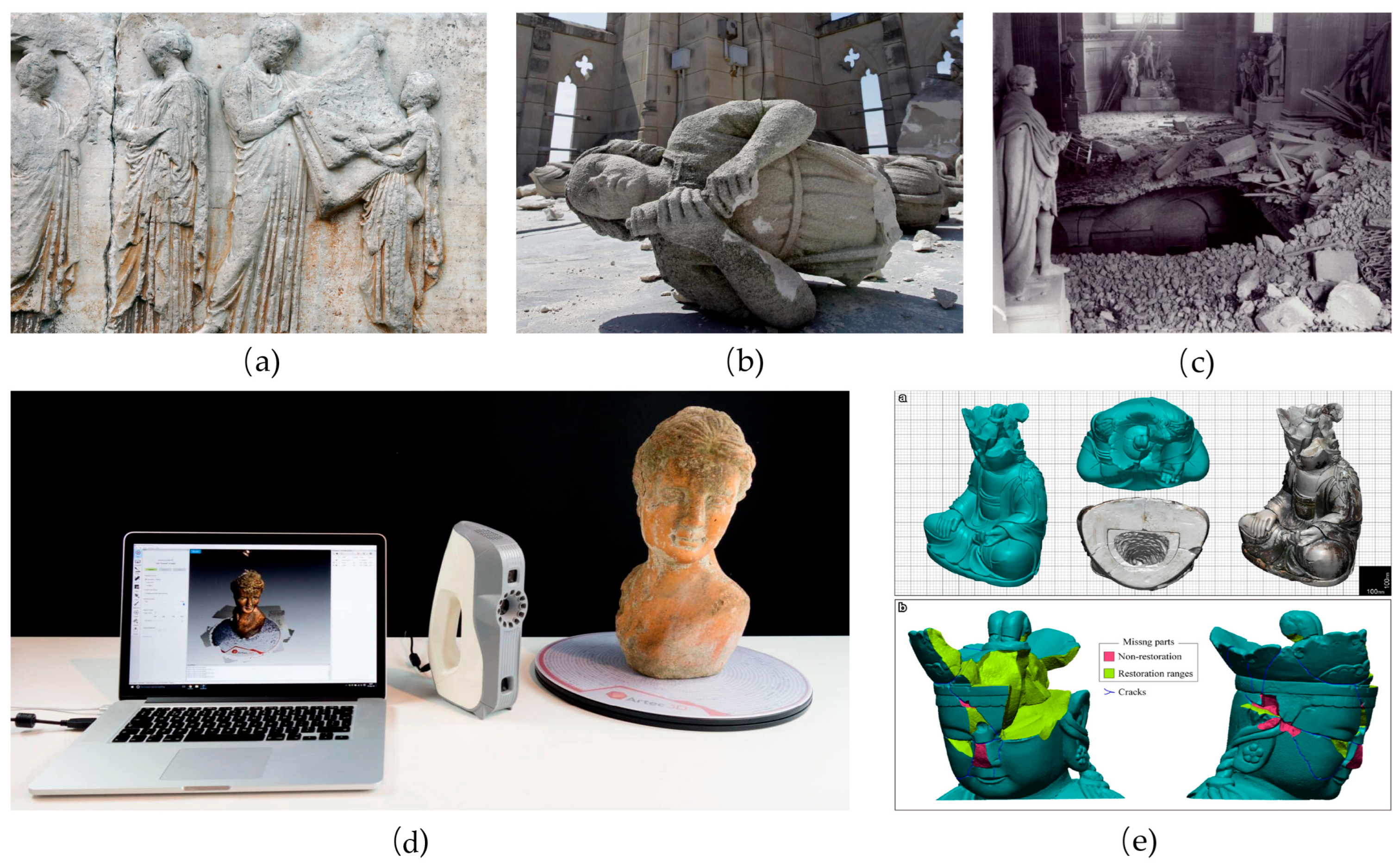
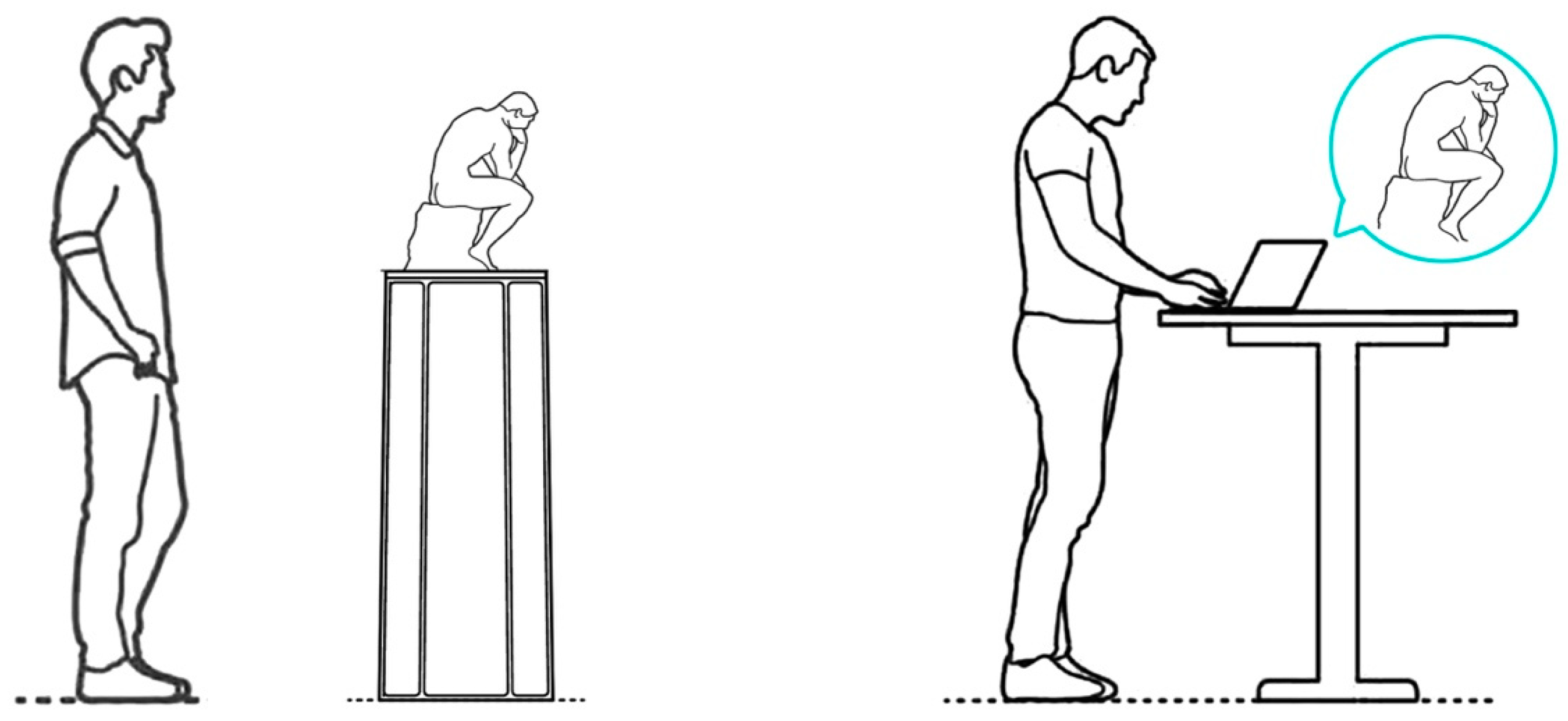
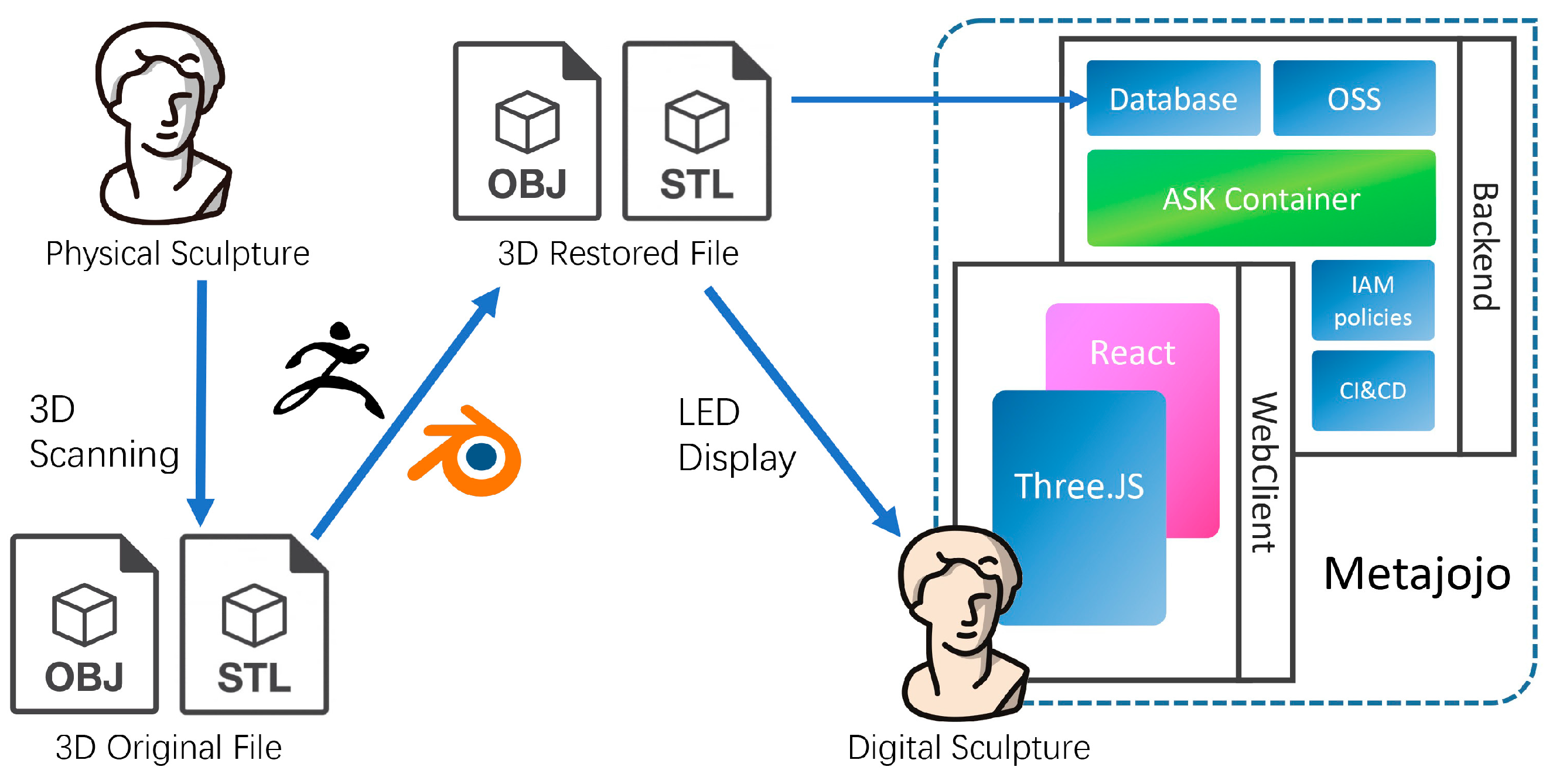
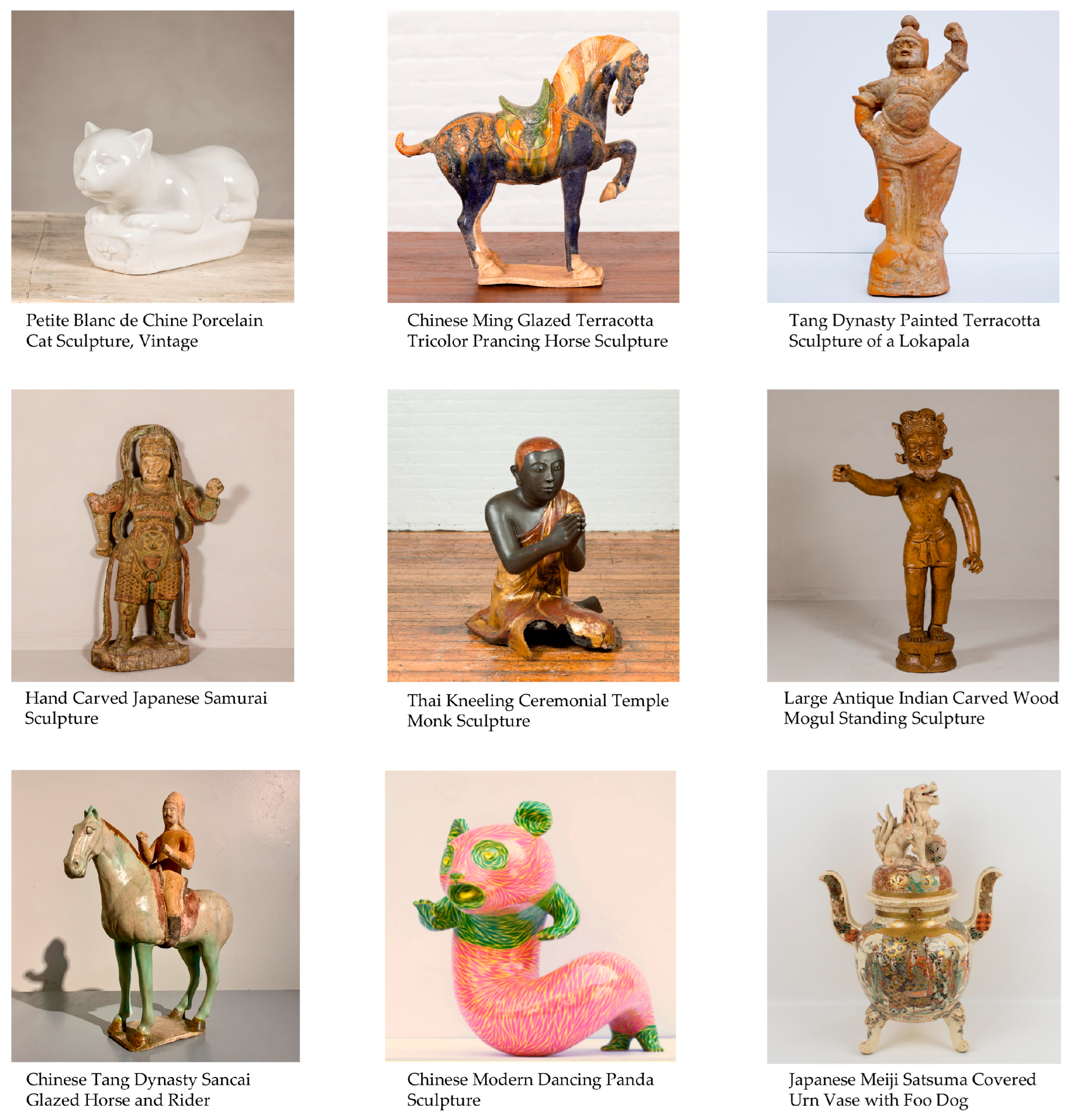


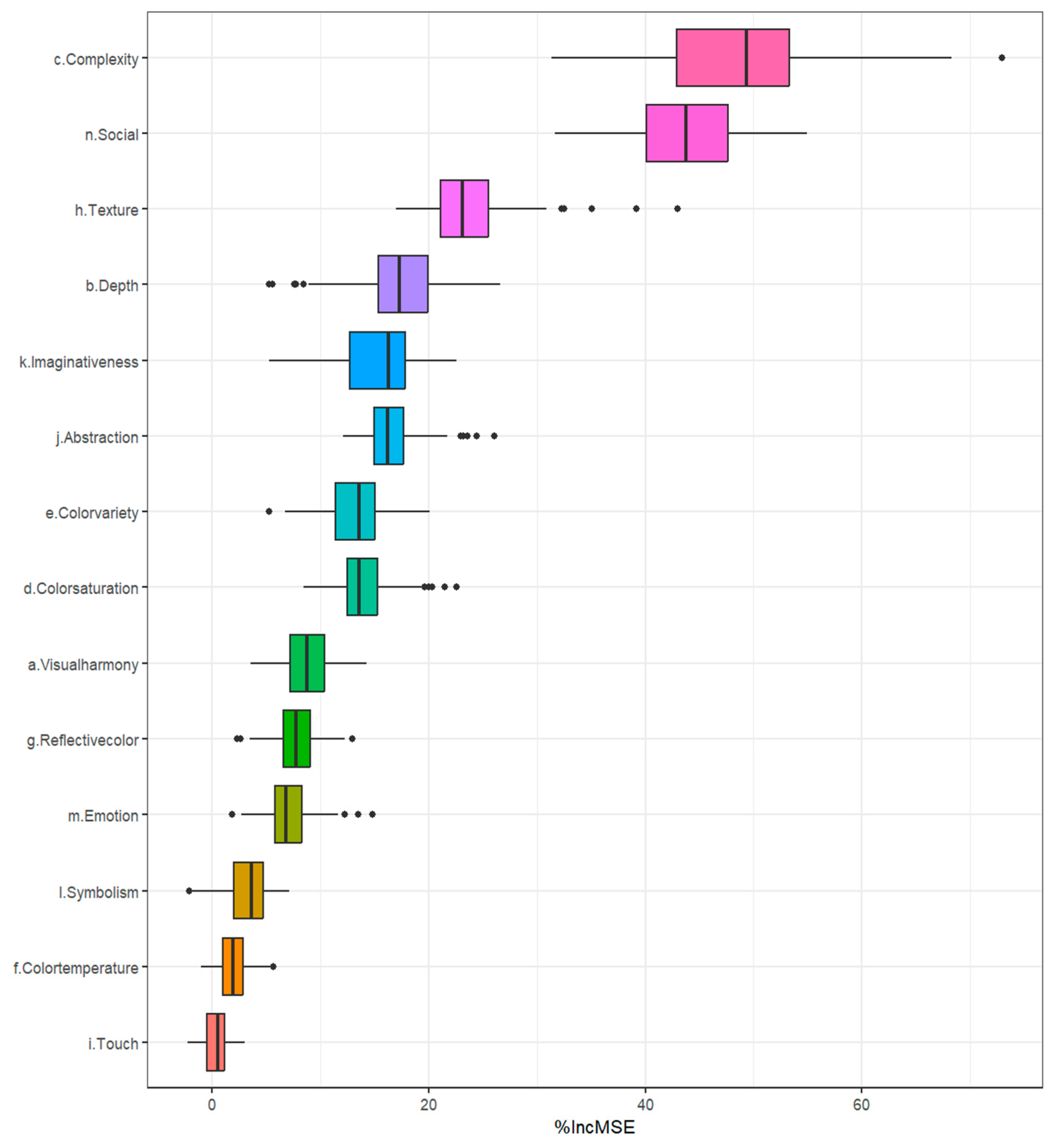
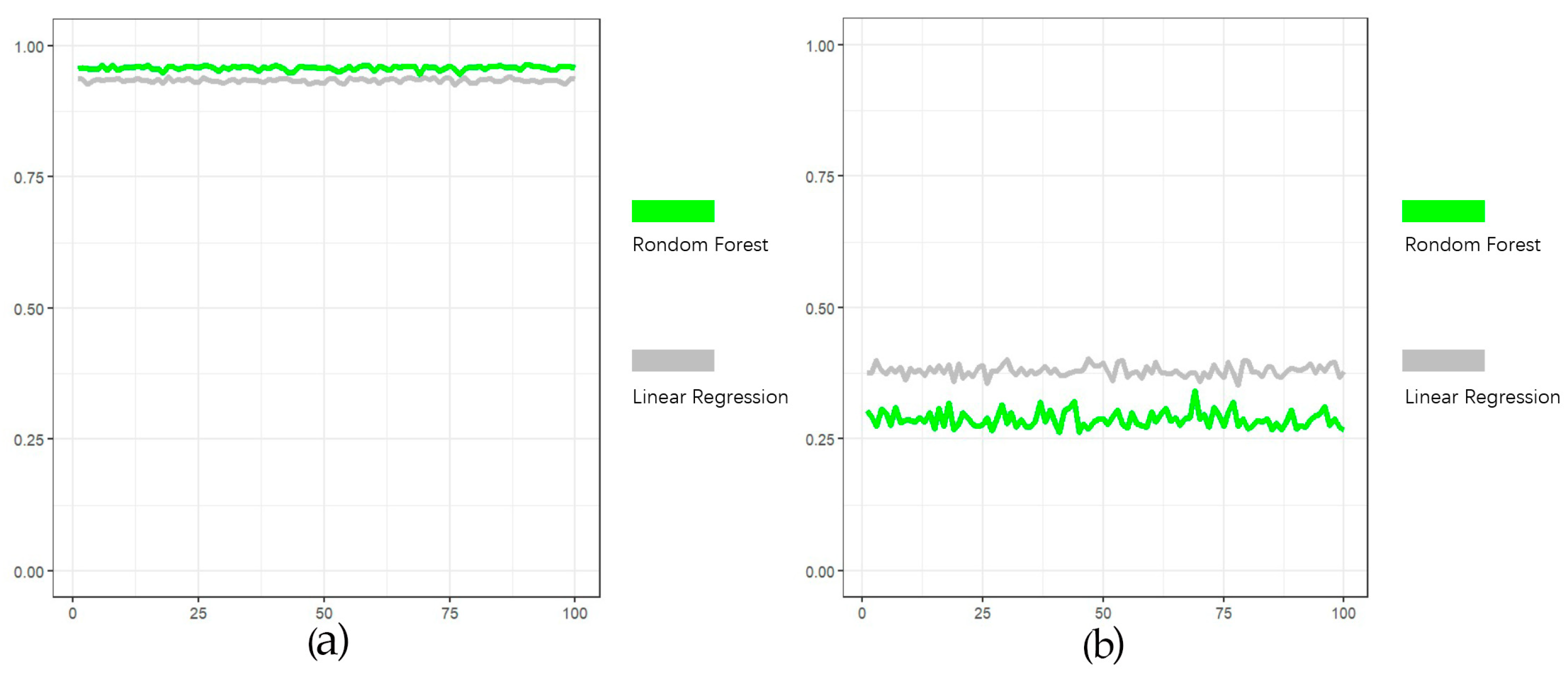
| Attributes | Instructions | Compare the Various Attributes of Digital Sculptures with Physical Sculptures | ||||
|---|---|---|---|---|---|---|
| Items | Very Poor | Poor | Acceptable | Good | Very Good | |
| Formal–Perceptual Attributes | a. Visual Harmony | 1 | 2 | 3 | 4 | 5 |
| b. Depth | 1 | 2 | 3 | 4 | 5 | |
| c. Complexity | 1 | 2 | 3 | 4 | 5 | |
| d. Colour Saturation | 1 | 2 | 3 | 4 | 5 | |
| e. Colour Variety | 1 | 2 | 3 | 4 | 5 | |
| f. Colour Temperature | 1 | 2 | 3 | 4 | 5 | |
| g. Reflective Colour | 1 | 2 | 3 | 4 | 5 | |
| h. Texture | 1 | 2 | 3 | 4 | 5 | |
| i. Touch | 1 | 2 | 3 | 4 | 5 | |
| Content–Representational Attributes | j. Abstraction | 1 | 2 | 3 | 4 | 5 |
| k. Imaginativeness | 1 | 2 | 3 | 4 | 5 | |
| l. Symbolism (ambiguity) | 1 | 2 | 3 | 4 | 5 | |
| m. Emotion | 1 | 2 | 3 | 4 | 5 | |
| Value | n. Social | 1 | 2 | 3 | 4 | 5 |
| o. Value | 1 | 2 | 3 | 4 | 5 | |
| Kaiser–Meyer–Olkin Measure of Sampling Adequacy | 0.623 | |
| Bartlett’s Test of Sphericity | Approx. Chi-Square | 228.212 |
| df | 105 | |
| Sig. | 0.000 | |
| Component | Initial Eigenvalues | Extraction Sums of Squared Loadings | Rotation Sums of Squared Loadings | ||||||
|---|---|---|---|---|---|---|---|---|---|
| Total | % of Variance | Cumulative % | Total | % of Variance | Cumulative % | Total | % of Variance | Cumulative % | |
| 1 | 3.535 | 23.568 | 23.568 | 3.535 | 23.568 | 23.568 | 2.847 | 18.977 | 18.977 |
| 2 | 1.884 | 12.558 | 36.126 | 1.884 | 12.558 | 36.126 | 2.055 | 13.700 | 32.678 |
| 3 | 1.535 | 10.235 | 46.361 | 1.535 | 10.235 | 46.361 | 1.612 | 10.750 | 43.427 |
| 4 | 1.263 | 8.417 | 54.779 | 1.263 | 8.417 | 54.779 | 1.518 | 10.121 | 53.548 |
| 5 | 1.145 | 7.634 | 62.413 | 1.145 | 7.634 | 62.413 | 1.330 | 8.865 | 62.413 |
| 6 | 0.972 | 6.479 | 68.892 | ||||||
| 7 | 0.879 | 5.862 | 74.754 | ||||||
| 8 | 0.737 | 4.915 | 79.669 | ||||||
| 9 | 0.695 | 4.633 | 84.302 | ||||||
| 10 | 0.601 | 4.009 | 88.311 | ||||||
| 11 | 0.551 | 3.675 | 91.986 | ||||||
| 12 | 0.452 | 3.012 | 94.999 | ||||||
| 13 | 0.341 | 2.274 | 97.272 | ||||||
| 14 | 0.227 | 1.513 | 98.786 | ||||||
| 15 | 0.182 | 1.214 | 100.000 | ||||||
| Formal–Perceptual Attributes | Content–Representational Attributes | Value Attributes | |
|---|---|---|---|
| Formal–Perceptual Attributes | 1 | ||
| Content–Representational Attributes | 0.275 * | 1 | |
| Value Attributes | 0.634 ** | 0.267 * | 1 |
| Variable Label | c. | n. | h. | b. | k. | j. | e. |
|---|---|---|---|---|---|---|---|
| Variable name | Complexity | Social | Texture | Depth | Imaginativeness | Abstraction | Color variety |
| Median number of %incMSE | 49.37168 | 43.72898 | 23.10214 | 17.29769 | 16.26351 | 16.203 | 13.59261 |
| Variable Label | d. | a. | g. | m. | l. | f. | i. |
| Variable name | Color saturation | Visual harmony | Reflective color | Emotion | Symbolism | Color temperature | Touch |
| Median number of %incMSE | 13.5879 | 8.759652 | 7.739252 | 6.814153 | 3.618531 | 1.947541 | 0.568246 |
Disclaimer/Publisher’s Note: The statements, opinions and data contained in all publications are solely those of the individual author(s) and contributor(s) and not of MDPI and/or the editor(s). MDPI and/or the editor(s) disclaim responsibility for any injury to people or property resulting from any ideas, methods, instructions or products referred to in the content. |
© 2024 by the authors. Licensee MDPI, Basel, Switzerland. This article is an open access article distributed under the terms and conditions of the Creative Commons Attribution (CC BY) license (https://creativecommons.org/licenses/by/4.0/).
Share and Cite
Yang, C.; Liu, Y. Preserving Sculptural Heritage in the Era of Digital Transformation: Methods and Challenges of 3D Art Assessment. Sustainability 2024, 16, 5349. https://doi.org/10.3390/su16135349
Yang C, Liu Y. Preserving Sculptural Heritage in the Era of Digital Transformation: Methods and Challenges of 3D Art Assessment. Sustainability. 2024; 16(13):5349. https://doi.org/10.3390/su16135349
Chicago/Turabian StyleYang, Chen, and Yang Liu. 2024. "Preserving Sculptural Heritage in the Era of Digital Transformation: Methods and Challenges of 3D Art Assessment" Sustainability 16, no. 13: 5349. https://doi.org/10.3390/su16135349
APA StyleYang, C., & Liu, Y. (2024). Preserving Sculptural Heritage in the Era of Digital Transformation: Methods and Challenges of 3D Art Assessment. Sustainability, 16(13), 5349. https://doi.org/10.3390/su16135349



_Lu.png)


